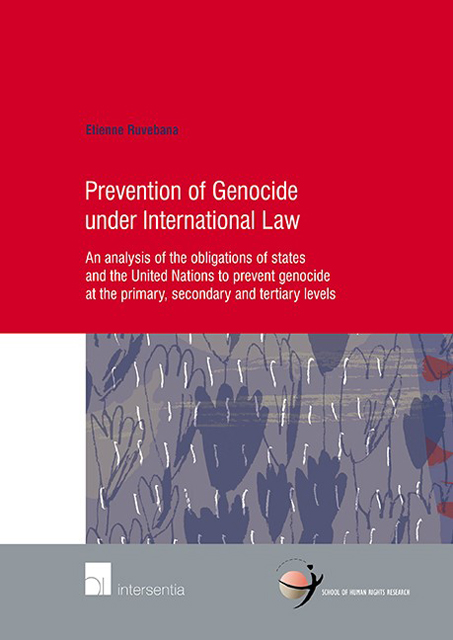 Prevention of Genocide Under International Law
Prevention of Genocide Under International Law Book contents
- Frontmatter
- Acknowledgements
- Contents
- List of Abbreviations
- Chapter I General Introduction
- Chapter II The Concept of Prevention as Understood in various Fields
- Chapter III The Concept of Prevention in the Field of Genocide in General
- Chapter IV Prevention of Genocide Under International Law
- Chapter V The Obligation of Territorial States to Prevent Genocide Under International Law
- Chapter VI Prevention of Genocide by Non-Territorial States Under International Law
- Chapter VII The United Nations and the Obligation to Prevent Genocide Under International Law
- Chapter VIII Prevention of Genocide and the Concept of the Responsibility to Protect
- Chapter IX Summary and General Conclusions
- Bibliography
- Samenvatting
- Curriculum Vitae
- School of Human Rights Research Series
Chapter IX - Summary and General Conclusions
Published online by Cambridge University Press: 24 November 2022
- Frontmatter
- Acknowledgements
- Contents
- List of Abbreviations
- Chapter I General Introduction
- Chapter II The Concept of Prevention as Understood in various Fields
- Chapter III The Concept of Prevention in the Field of Genocide in General
- Chapter IV Prevention of Genocide Under International Law
- Chapter V The Obligation of Territorial States to Prevent Genocide Under International Law
- Chapter VI Prevention of Genocide by Non-Territorial States Under International Law
- Chapter VII The United Nations and the Obligation to Prevent Genocide Under International Law
- Chapter VIII Prevention of Genocide and the Concept of the Responsibility to Protect
- Chapter IX Summary and General Conclusions
- Bibliography
- Samenvatting
- Curriculum Vitae
- School of Human Rights Research Series
Summary
SUMMARY
The main question that this work has treated is what the obligation to prevent genocide in international law entails to its bearers. This implied also the question about who those bearers are. The aim was to examine whether and to what extent international law should be understood/interpreted/developed in a way that it allows or enables a more effective prevention of genocide in order to achieve the goal for which the laws on the prohibition of genocide have been put in place. It thus provided an assessment of the international legal regime on the prevention of genocide and on what that obligation requires its bearers to do, when, where, and how, while at the same time identifying where there are shortcomings and suggesting how things can be improved. The context, research question, objective, sources and structure of the work have been given in chapter I on the general introduction.
Before going far in those legal questions, a primary question related to the main one needed an answer. This is the question what prevention itself means. Being a word used in different fields, prevention is elaborated on in chapter II in order to explain its meaning and structure in some of those fields, namely public health, non-proliferation of nuclear weapons, criminology, environmental law and torture. For all those fields, prevention means to avert harm from occurring. It requires taking appropriate preventive measures at the right moment. For some fields like public health and criminology, the structure of prevention is explicitly divided in different temporal divisions which are the primary, secondary and tertiary levels. The primary level consists of the period before the existence of signs of harm. While the secondary level is the period when there are symptoms/signs of harm, the tertiary level is when the harm is occurring. For each level, there are preventive measures tailored to it in order to avoid that the situation becomes worse. For those other fields which do not use this temporal division as such, it has been shown from the nature of the preventive measures needed that these levels are also implied. In Chapter III, the question becomes to know what that meaning of prevention and structure means to the prevention of genocide (i.e. whether it can apply to genocide as well.
- Type
- Chapter
- Information
- Prevention of Genocide Under International LawAn Analysis of the Obligations of States and the United Nations to Prevent Genocide at the Primary, Secondary and Tertiary Levels, pp. 317 - 324Publisher: IntersentiaPrint publication year: 2014
